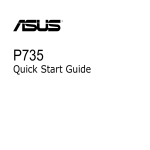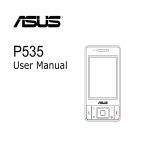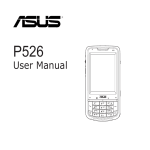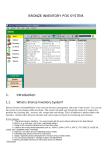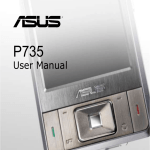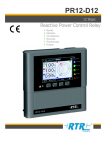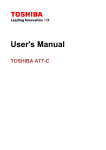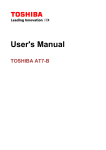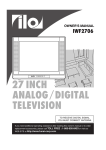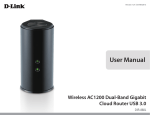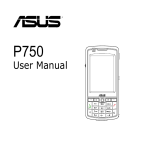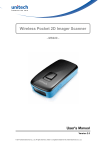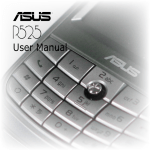Download Asus P735 User manual
Transcript
P735 User Manual E2997 First Edition February 2007 Copyright © 2007 ASUSTeK Computers, Inc. All Rights Reserved. No part of this manual, including the products and software described in it, may be reproduced, transmitted, transcribed, stored in a retrieval system, or translated into any language in any form or by any means, except documentation kept by the purchaser for backup purposes, without the express written permission of ASUS Computer Inc. (“ASUS”). Product warranty or service will not be extended if: (1) the product is repaired, modified or altered, unless such repair, modification of alteration is authorized in writing by ASUS; or (2) the serial number of the product is defaced or missing. ASUS PROVIDES THIS MANUAL “AS IS” WITHOUT WARRANTY OF ANY KIND, EITHER EXPRESS OR IMPLIED, INCLUDING BUT NOT LIMITED TO THE IMPLIED WARRANTIES OR CONDITIONS OF MERCHANTABILITY OR FITNESS FOR A PARTICULAR PURPOSE. IN NO EVENT SHALL ASUS, ITS DIRECTORS, OFFICERS, EMPLOYEES OR AGENTS BE LIABLE FOR ANY INDIRECT, SPECIAL, INCIDENTAL, OR CONSEQUENTIAL DAMAGES (INCLUDING DAMAGES FOR LOSS OF PROFITS, LOSS OF BUSINESS, LOSS OF USE OR DATA, INTERRUPTION OF BUSINESS AND THE LIKE), EVEN IF ASUS HAS BEEN ADVISED OF THE POSSIBILITY OF SUCH DAMAGES ARISING FROM ANY DEFECT OR ERROR IN THIS MANUAL OR PRODUCT. SPECIFICATIONS AND INFORMATION CONTAINED IN THIS MANUAL ARE FURNISHED FOR INFORMATIONAL USE ONLY, AND ARE SUBJECT TO CHANGE AT ANY TIME WITHOUT NOTICE, AND SHOULD NOT BE CONSTRUED AS A COMMITMENT BY ASUS. ASUS ASSUMES NO RESPONSIBILITY OR LIABILITY FOR ANY ERRORS OR INACCURACIES THAT MAY APPEAR IN THIS MANUAL, INCLUDING THE PRODUCTS AND SOFTWARE DESCRIBED IN IT. Products and corporate names appearing in this manual may or may not be registered trademarks or copyrights of their respective companies, and are used only for identification or explanation and to the owners’ benefit, without intent to infringe. Table of Contents P735 specifications................................................................................ 8 Package contents................................................................................... 9 Chapter 1: Getting started Getting to know your P735.................................................................. 12 Layout ...................................................................................................... 12 Device components description..................................................................... 14 Getting your device ready.................................................................... 16 Installing the SIM card and battery................................................................ 16 Charging the battery...................................................................................... 18 Starting up............................................................................................. 19 Powering your device..................................................................................... 19 Using the stylus.............................................................................................. 19 Calibrating P735............................................................................................ 20 Locking the keys and buttons........................................................................ 20 The Today screen................................................................................. 21 Status indicators............................................................................................ 22 Screen orientation.......................................................................................... 25 Start menu..................................................................................................... 26 Chapter 2: Entering data Using the Input Panel.......................................................................... 28 Using the Block Recognizer........................................................................... 28 Using the On-screen keyboard...................................................................... 29 Using the Letter Recognizer.......................................................................... 30 Using the Transcriber..................................................................................... 31 Writing and drawing on the screen..................................................... 32 Recording voice.................................................................................... 33 Using ActiveSync™.............................................................................. 35 Synchronizing via mini-USB........................................................................... 37 Synchronizing with Exchange Server................................................. 38 Setting the synchronization schedule............................................................ 40 Searching information.......................................................................... 41 Getting Help.......................................................................................... 42 Chapter 3: Phone features Using the phone.................................................................................... 44 Phone pad...................................................................................................... 44 Using flight mode........................................................................................... 44 Adjusting the device volume.......................................................................... 45 Making a call......................................................................................... 46 Using the phone pad...................................................................................... 46 Making calls from Contacts............................................................................ 48 Making calls from Call History........................................................................ 48 Using the Speed Dial..................................................................................... 49 Using Voice Commander............................................................................... 50 Receiving a call..................................................................................... 51 Chapter 4: Wireless features Using the Wireless Manager................................................................ 54 Using Bluetooth®............................................................................................. 55 Overview ...................................................................................................... 55 Activating Bluetooth in your device................................................................ 55 Configuring Bluetooth ................................................................................... 56 Using WLAN (IEEE 802.11b/g)............................................................. 62 Introduction.................................................................................................... 62 Activating WLAN in your device..................................................................... 62 Configuring WLAN ........................................................................................ 63 Setting a GPRS connection................................................................. 65 Connecting GPRS.......................................................................................... 68 Disconnecting GPRS..................................................................................... 69 Using the GPRS Tool..................................................................................... 70 Chapter 5: My Secrets Using My Secrets.................................................................................. 72 Enabling My Secrets...................................................................................... 72 Unlocking My Secrets.................................................................................... 74 Locking My Secrets........................................................................................ 75 My Secrets setting......................................................................................... 76 Disabling My Secrets..................................................................................... 79 Chapter 6: Multimedia features Using the camera.................................................................................. 84 Launching the camera................................................................................... 84 Navigation button functions in camera mode................................................. 85 Camera mode screen.................................................................................... 87 Taking photos................................................................................................. 95 Video mode screen........................................................................................ 96 Recording videos......................................................................................... 102 Viewing pictures and video............................................................... 104 Viewing pictures and video.......................................................................... 104 Chapter 7: Other features WorldCard Mobile............................................................................... 106 Using the WorldCard Mobile........................................................................ 107 Remote Presenter............................................................................... 109 Using the Remote Presenter........................................................................ 109 Setting ring tone..................................................................................115 Adding ring tone to selection.........................................................................115 Changing the ring tone..................................................................................116 Wake-up setting...................................................................................117 Mode switcher......................................................................................118 System information.............................................................................119 Restoring default factory settings.................................................... 120 Chapter 8: Device component status ASUS status icon................................................................................ 122 CPU mode setting........................................................................................ 123 USB setting.................................................................................................. 123 LCD Brightness............................................................................................ 124 Battery .................................................................................................... 124 Memory .................................................................................................... 125 Storage card memory.................................................................................. 125 Programs running in memory....................................................................... 126 Settings .................................................................................................... 126 Appendix Notices................................................................................................. 128 Contact information............................................................................ 132 P735 specifications Processor Marvell XScale® processor, 520MHz Operating System Microsoft® Windows Mobile™ 5.0 Pocket PC Phone Edition Memory 256 MB NAND Flash ROM 64 MB SDRAM Display 2.8-inch, 65, 536-color, 240 x 320-resolution, TFT touch screen LCD Frequency band UMTS 2100 MHz, Tri-band GSM (900/1800/1900 MHz) GPRS Class B, Multislot class 10 Camera 2.0 mega-pixel CMOS camera with Auto-Focus (AF) and built-in flash Connectivity WLAN Bluetooth USB Battery capacity 1300 mAh Lithium Ion Expansion slot MiniSD card slot Audio 2.5 mm audio port Built-in microphone and speaker Weight 143g (with battery) Dimension 109 x 59 x 19 mm Talk time* 4(3G) hrs ~5(2G) hrs (*vary with different networking environment and scenario) Standby time* 170~220(3G) hrs; 180~220(2G) hrs (*vary with different networking environment and scenario) : 802.11b/g : V2.0 : USB Client 1.1 NOTE: Specifications are subject to change without notice. Package contents Check your P735 package for the following items: P ASUS P735 device P Battery P AC Adapter P Mini-USB cable P Headset P Stylus P Protection case P Getting Started CD P User Manual P Quick Start Guide P Warranty Card NOTE: If any of the above items is damaged or missing, contact your retailer. CAUTION: • To reduce risk of fire, use only correct battery type. Refer to “Installing the SIM card and battery” section for details. • Do not attempt to disassemble the battery pack. • Dispose of used batteries properly. Inquire from local authorities for proper disposal of battery. 10 Chapter Getting started 1 • Getting to know your P735 • Getting your device ready • Starting up • The Today screen 11 Getting to know your P735 Components: Layout 3 2 1 3 Stylus I 4 Camera button Top features 7 1 MiniSD slot 2 Power button 5 Volume controller 6 Reset button 9 8 7 Notification LED 4 8 Earpiece receiver 9 Sub camera lens 10 LCD touch screen 11 Call key 5 10 12 Left Soft key 13 Video call button 14 Navigation buttons 15 Action button 16 Right Soft key 12 17 Mode/Task switcher button 16 18 End key 6 11 13 Left side features 12 18 15 17 14 Front features Getting to know your P735 Components: 19 Camera flash light 20 Self-portrait mirror 20 19 24 22 21 25 21 Camera lens 22 Speaker 23 Battery compartment 24 Voice recorder button 25 Hold button 23 26 Earphone slot 27 Mini-USB connector 28 Mic Right side features Rear features 26 27 Bottom features 28 13 Device components description No. 14 Item Description 1 MiniSD slot Allows you to insert a MiniSD storage card. 2 Power button Press to turn the power ON or to set suspend mode or to wake device from sleep mode. Press and hold to turn the power OFF. 3 Stylus Use the stylus to write, draw, or select items on the touch screen. 4 Camera/Shutter button Press to launch the camera. In camera mode, half-press to autofocus then full-press to take a picture. In video mode, full-press to start recording video and press again to stop. 5 Volume controller Press the arrow buttons to adjust the volume. 6 Reset button Using the stylus, press reset button to soft-reset your device. 7 Notification LED This multi-color LED notifies the following: • Green - Phone fully charged. • Flashing green - Network detected. • Red - Phone is charging. • Flashing red - Event notification. • Flashing blue - Bluetooth® or WLAN(IEEE 802.11b/g) ON. 8 Earpiece receiver Allows you to listen to incoming/outgoing calls. 9 Sub camera lens This sub camera is for the video conference. 10 LCD touch screen This 2.8-inch, 65536-color, 240 x 320-resolution, touchscreen TFT LCD allows you to write, draw, or make selections using the stylus. 11 Call key Press to receive an incoming call or make a call. 12 Left Soft key Performs the command indicated above the button. 13 Video call button Press to make video calls. Device components description No. Item Description 14 Navigation buttons Use to move through menus. Press the center to run an application or in camera mode, press to take a picture. 15 Action button Press to carry out the task of selected item. 16 Right Soft key Performs the task indicated above the button. 17 Mode/Task switcher button Allows you to switch applications and tasks. Press and hold this button to turn on/off the flashlight. 18 End key Press to end a call. 19 Camera flashlight Allows you to capture images in a dim environment. Press and hold the mode switcher button to turn this flashlight on/off. 20 Self-Portrait Mirror Position your device until this mirror reflects the image you want to capture. 21 Camera lens This 2-megapixel camera comes with Auto-Focus (AF) lens and flash light features. 22 Speaker Allows you to listen audio media and phone calls. 23 Battery compartment Contains the battery that supplies power to the device. 24 Voice recorder button Press to luanch the voice commander. Press and hold to launch the record application to record voice. 25 Hold button Slide to enable or disable all keys including the LCD touch screen. 26 Earphone port Plug headset accessory to this port. 27 Mini-USB connector Use this connector to synchronize your data or to charge the battery. 28 Mic Used to make or receive phone calls, record sounds, record voice, or say voice commands. NOTE: The Voice Command utility is supported in selected languages only. 15 Getting your device ready Installing the SIM card and battery Before you can make a phone call using your P735, you need to install a Subscriber Identity Module (SIM) card. A SIM card contains your phone number, subscriber details, phonebook, and additional phone memory. Your P735 comes with a rechargeable Lithium-Ion battery. New batteries come partially discharged and should be fully charged before using them. They generally do not reach their rated capacity until they have been charged and discharged at least four (4) times. We recommend that new batteries be charged overnight even though they may indicate that the charge is complete after a few hours. Sometimes charging may stop during the initial charge and it is necessary to remove the battery for approximately fifteen (15) minutes and then put it back on charge. CAUTION: Use only an ASUS qualified battery. To install a SIM card and battery: 1. Remove the battery compartment cover. NOTE: When turned on, the device automatically turns off after you open the battery compartment to prevent data loss. 16 2. Remove the battery. 3. Insert the SIM card with its gold contacts facing down and the notched corner oriented to the upper left corner of the slot as shown. 4. Replace the battery into the compartment with its copper contacts properly aligned to the copper conductor on the device. 5. Replace battery compartment cover. 17 Charging the battery The bundled battery pack is shipped partially charged. Charge the battery up to four (4) hours before using for the first time. To charge battery: 1. Connect the AC adapter plug to the mini-USB connector at the bottom of the device. 2. Connect the AC power plug to a grounded wall socket or power strip. NOTE: • The notification LED turns red and charging battery icon appears on the status bar indicating that the battery is charging. • If your battery gets totally discharged, you need to recharge it for at least twenty minutes before you can turn it back on. 18 Starting up Powering your device Make sure that your P735 is fully-charged before starting the device for the first time. To turn on power: 1. Press and hold the power button. Power button 2. Follow onscreen instructions to align screen and set the local time zone. Using the stylus The stylus is a pen-like device found behind the upper right corner of your P735. • Use the stylus to write, draw, select, or drag an item on the screen. • Single-tap an item to select it. • Tap and hold an item to see a menu. Stylus 19 Calibrating P735 Calibrating your device ensures that the item you tap on the screen is activated. This involves tapping in the center of targets that appear in various coordinates on the screen. To calibrate your screen: 1. Tap Start > Settings > System tab then tap Screen icon. 2. On the General tab tap Align Screen then follow succeeding calibration screen instructions. Locking the keys and buttons You can lock the keys and buttons of your device to avoid inadvertently dialing numbers or launching any application. To lock the keys and buttons: 1. Locate the Hold button on the right side of your device. 2. Slide the hold button downward to lock. 3. To unlock, slide the hold button upward. Hold button 20 The Today screen The Today screen displays information useful to you. You can configure the Today screen to have all the important information you need. • To access the Today screen, tap Start > Today. • To personalize the Today screen, tap Start > Settings > Personal tab > Today. The following describes the common information found on the today screen: Status bar Tap to open the Start menu Tap to setup date, time, and alarm Indicates the battery status Tap to adjust volume Displays the signal status Tap to launch Wireless Manager Tap to set user information Tap to open messages Tap to setup tasks Tap to setup profile Tap to read or make appointments Tap to sign in Pocket MSN Tap to view connectivity status Displays the Bluetooth® connection status Tap to change Bluetooth settings Tap to display system CPU, USB setting, LCD brightness, battery, memory, and MiniSD status Tap to change WLAN (IEEE 802.11b/g) settings Tap to lock, unlock, or change My Secrets settings (Appears only when My Secrets is enabled.) Tap to change screen orientation Tap to display call history Tap to launch Contacts list 21 Status indicators Refer to the table below for the Today screen icon status indicators. Icon Description General Packet Radio Services (GPRS) available. Connecting via GPRS. Connected via GPRS. Connecting with ActiveSync ActiveSync connection not active. ActiveSync synchronization in progress. Synchronization error. Call forwarded. Call in progress. Call on hold. Missed call. New message. 22 Status indicators Icon Description New voice mail. No cellular phone service. No signal. Searching for cellular phone service. Indicates signal strength. Sound OFF. Sound ON. Battery low. Battery extremely low. Battery partially charged. Battery charging. Battery fully charged. Searching Wi-Fi connection. 23 Status indicators Icon Description Wi-Fi active. Roaming service. This icon appears only if you have international roaming feature. Vibrate or silent mode on. Bluetooth headset connected. Bluetooth headset connected with sound. Appears when you set the alarm No SIM installed. Notice indicator. Tap to view notice. Pocket MSN service notification. Pocket MSN chat is online. 3G network available 3G connected ActiveSync over 3G in use 24 Screen orientation You can set the screen to three different orientations: 1. Portrait 2. Landscape (right-handed) 3. Landscape (left-handed) Set to Portrait mode to get a better view or better operation of certain applications on your device. Set to Landscape when viewing pictures, video or viewing longer text files. To change the screen orientation, tap Start > Setting > System tab > Screen then select the orientation you want. You can also change the orientation by tapping the icon. Landscape mode Portrait mode 25 Start menu The Start menu contains various programs and applications that you commonly use. Tap Start to display the start menu items: Portrait mode Landscape mode You can also customize the items that appear in the Start menu. To do this: 1. Tap Start > Settings > Personal tab > Menus. 2. Select the check boxes of the items you want to appear in the Start menu. You can select up to seven (7) items. 26 Chapter Entering data 2 • Using the Input Panel • Writing and drawing on the screen • Recording voice • Using ActiveSync™ • Synchronizing with Exchange Server • Searching information • Getting Help 27 Using the Input Panel When you start an application or select a field that requires text, symbols, or numbers, the Input Panel icon appears on the menu bar. The Input Panel allows you to select various input methods including: Block Recognizer, Keyboard, Letter Recognizer, and Transcriber. Using the Block Recognizer The Block Recognizer allows you to use a single stroke to write letters, numbers, symbols, or punctuations, which are converted into typed text. To use the Block Recognizer: 1. In an application, tap the Input Panel arrow, then tap Block Recognizer. 2. Write letters, numbers, symbols, or punctuations in the designated writing area. • Write letters on the abc (left) area of the box. • Write numbers on the 123 (right) area of the box. • Tap the special symbols button to key in symbols, punctuations and other special characters. • Tap Help “?” button for help on how to write characters. Tap for special characters Input panel 28 Using the On-screen keyboard With the on-screen keyboard, you can key in text, symbols, numbers, or other special characters when input is possible. To input text using the on-screen keyboard: 1. In an application, tap the Input Panel arrow, then tap Keyboard. 2. Key in text by tapping keys on the on-screen keyboard. Input panel To enlarge the on-screen keyboard: 1. Tap the Input Panel arrow, then tap Option. 2. Select Keyboard from the Input Method list. 3. Tap Large Keys. 29 Using the Letter Recognizer With the Letter Recognizer you can write individual letters, numbers, or special characters, which are converted into typed text. To use the Letter Recognizer: 1. In an application, tap the Input Panel arrow, then tap Letter Recognizer. 2. Write letters, numbers, symbols, or punctuations in the designated writing area. • Write capital letters on the ABC (left) area of the box. • Write lower case letters on the abc (middle) area of the box. • Write numbers on the 123 (right) area of the box. • Tap the special symbols button to key in symbols, punctuations and other special characters. • Tap Help “?” button for help on how to write characters. Tap for special characters Input panel 30 Using the Transcriber Transcriber is a handwriting recognition program that allows you to write in cursive, print, or mixed styles. It reliably recognizes not only written text but also numbers and symbols. Make sure to write legibly. See Help for more information on the Transcriber. To use the Transcriber: 1. Start an application that accepts user input, such as Notes or Word Mobile. 2. Tap the Input Panel arrow, then tap Transcriber. To write using Transcriber (using Notes): 1. Tap screen to position the cursor where you want the text to appear. 2. Use the stylus to write on the screen. The handwriting will be converted to text after you lift the stylus from the screen. To edit text: 1. Draw a line across the text you want to edit. After you lift the stylus from the screen, the line will disappear and the selected text will be highlighted. 2. You can now rewrite the text or use the Transcriber gestures to edit your selected text. See Help for the Transcriber gestures. Tap for Help Input panel 31 Writing and drawing on the screen You can write or draw directly on the screen and save notes in your own handwriting. If you prefer to use your own handwriting or use drawings in your notes, set the default input mode to Writing. If you prefer text, set the default mode to Typing. To set the default input mode for Notes: 1. Tap Start > Programs > Notes. 2. From the Notes list, tap Menu > Options. 3. In the Default mode: box, tap the down arrow and select any of the following: • Writing - if you want to draw or enter handwritten text in a note. • Typing - if you want to create a typed note. 4. Set the other options according to your preference. 5. Tap when finished. To write a note: 1. Tap Start > Programs > Notes. 2. From the Notes list, tap New. 3. Write your text on the screen. 4. When finished, tap 32 to return to the Notes list. Recording voice At any time, whether your phone is on stand-by or active mode, you can record sound, voice, or add a recording to a note while using your device. To start a voice recording: 1. Press and hold Record button to launch voice recorder application. 2. Tap the record icon to begin recording. 3. Place the receiver near your mouth or source of sound. Record button 4. Tap the stop icon when finished recording. A recording icon appears on the note. 5. Tap . To create a voice recording using Notes: 1. Tap Start > Programs > Notes. 2. From the Notes list, tap New. 3. If you do not see the recording toolbar, tap Menu > View Recording Toolbar. 4. Tap the record icon to begin recording. 5. Place the receiver near your mouth or source of sound. 6. Tap the stop icon when finished recording. A recording icon appears on the note. 7. Tap . 33 To add a recording to a saved note: 1. Tap Start > Programs > Notes. 2. From the Notes list, tap to open a saved note. 3. If you do not see the recording toolbar, tap Menu > View Recording Toolbar. 4. Tap the record icon to begin recording. 5. Place the receiver near your mouth or source of sound. 6. Tap the stop icon when finished recording. A recording icon appears on the note. 7. Tap 34 . Using ActiveSync™ ActiveSync™ allows you to synchronize data in your device with data in your computer. ActiveSync can also synchronize over a wireless or cellular network with Microsoft Exchange Server, provided that your cellular phone service or company is running Microsoft Exchange Server with Exchange ActiveSync. When synchronized directly with Exchange Server, you can stay up to date even when your PC is turned off. During synchronization, ActiveSync compares the data in your device with the data in your computer or Exchange Server, and updates all data with recent changes. You can select and synchronize data in the following locations using ActiveSync: • Contacts • Calendar • Email • Tasks • Notes • Favorites • Files • Media You can also exchange data between your computer and device without synchronizing. ActiveSync is already installed in your device, but before you can synchronize data with your computer, you must first install ActiveSync in your computer. Install ActiveSync from the Microsoft Getting Started CD that came with your device package. After you have installed ActiveSync, set up a sync relationship between your device and your computer. ActiveSync recognizes your device and automatically transfers the synchronization settings you have in your device. 35 If you wish to synchronize your device with Exchange Server through your company or service provider, obtain the name of the Exchange Server, user name, password, and domain name from your network administrator before starting the Sync Setup Wizard. To install and configure ActiveSync in your computer: 1. Insert the Microsoft Getting Started CD that came with your device package. 2. Follow succeeding screen instructions. 3. After the setup is complete, the Sync Setup Wizard automatically starts when you connect your device to your computer. Follow screen instructions to complete the wizard. 4. From the Sync Setup Wizard, you can: • Configure an Exchange Server connection to synchronize directly with an Exchange Server. Acquire from your network administrator the required parameters for input. • Create a synchronization relationship between your computer and your device. 5. Select the information type that you want to synchronize. 6.After you finish the wizard, ActiveSync automatically synchronizes your device. You can disconnect the device after the synchronization is complete. NOTE: • When connected, your device is automatically synchronized with your computer. ActiveSync synchronizes everytime you make a change on either the device or computer. • You cannot use WLAN to synchronize database. • Refer to your Windows® Mobile Help, for more information about ActiveSync synchronization. 36 Synchronizing via mini-USB You can connect to your device using the bundled mini-USB cable to synchronize to your computer. To synchronize your device via mini-USB: 1. After installing ActiveSync to your computer, connect the mini-USB plug to the mini-USB connector at the bottom of the device. 2. Connect the other end of the USB cable to your computer. Upon connection, ActiveSync automatically synchronizes your device. 37 Synchronizing via Bluetooth You can connect your device to your computer using the Bluetooth wireless technology. To synchronize your device via Bluetooth: 1. Configure Bluetooth in your computer to support ActiveSync. Refer to the ActiveSync Help in your computer for instructions. 2. Turn on Bluetooth in your device. See “Using Bluetooth” section in Chapter 4 for details. 3. On your device, tap Start > Programs > ActiveSync. 4. From the ActiveSync screen, tap Menu > Connect via Bluetooth. Make sure your device is within Bluetooth range with your computer. If this is the first time you connect to this computer via Bluetooth, perform the Bluetooth wizard in your device and setup a Bluetooth partnership between your device and computer. Refer to Chapter 4 for Bluetooth wireless connection settings. 38 Synchronizing with Exchange Server To synchronize your device with Exchange Server: 1. From the ActiveSync menu, tap Menu > Add Server Source. 2. In the Server Address field, input the address of the server running Exchange Server then tap Next. If necessary, tap the check box This server requires an encrypted (SSL) connection. 39 3. Input your name, password, and domain then tap Next. 4. Tap the check boxes to select the data items that you want to synchronize with Exchange Server. To change the available synchronization settings, select a data item then tap Settings. Tap Finish when done. 5. Start the sync process. 40 Setting the synchronization schedule To set the synchronization with Exchange Server: 1. From the ActiveSync screen, tap Menu > Schedule. 2. Refer to the table for input details. Volume Recommended setup High Select a shorter interval in the Peak times list. Low Select As items arrive option or a longer interval in the Off-peak times list. While roaming Check Use above settings while roaming. Sending messages Check Send outgoing items immediately. 41 Searching information Using the search tool, you can search for files and other items stored in your device or the external MiniSD card. You can search by file name or by words located in various applications including the Calendar, Contacts, Excel Mobile, Word Mobile, Outlook Mobile, Help, Messages, Notes, and Tasks. You can also filter your search to files larger than 64 KB. To search for a file or an item: 1. Tap Start > Programs > Search. 2. In Search for field, input the file name, word, or other information you want to search. 3. In Type field, select the data type to help you filter your search. 4. Tap Search. Found items are listed in Results. 5. In the Results list, tap the item with the information you need. 42 Getting Help You can easily find Help for using any program on the device. To get help for a program: • From the Today screen or program, tap Start > Help. A page will open with links to topics that explain how to use the program. 43 44 Chapter Phone features 3 • Using the phone • Making a call • Receiving a call 45 Using the phone Like a standard cellular phone, you can use your P735 to make and receive calls. You can also keep a history of calls made and received, send SMS or MMS messages, take notes while talking, call from Contacts, and copy data from installed SIM card to your device. Phone pad The phone pad allows you to easily dial and access the Contacts, Call History, Speed Dial, Video Call, and Phone settings. To launch the Phone pad, do any of the following: • Tap Start > Phone. • Press the talk button. Using flight mode Generally, you are required to turn off your cellular phone onboard an aircraft during takeoff and landing. Flight mode enables you to turn off the phone function but keep your device turned on to use other functions. To use flight mode: 1.Tap the signal icon , or tap Start > Settings > Connections tab. 2.Tap Wireless Manager. 3.Tap Phone to turn on/off the phone connection. 46 Adjusting the device volume To adjust the device volume: 1. Tap the speaker icon. 2. From the volume menu, you can: •Adjust the phone volume or device volume by moving the slider to the desired volume level. • Tap On, Vibrate, or Off to change the system and ringer volume settings. You can also adjust the device volume by pressing the volume controller keys at the left side of the device. Press to increase volume Volume controller button Press to decrease volume or turn volume off. 47 Making a call You can make a phone call using the phone pad. You can also make calls directly from the Contacts, Call History, Speed Dial, or Voice Commander. Using the phone pad To make a call using the phone pad: 1. Tap Start > Phone. 2. From the phone screen, tap the number of the party you want to call then tap . If you tapped the wrong number, tap the back arrow to erase number to the left. Back arrow 3. Talk to the called party when connected. 4. When finished, tap to end the call. You can also launch the phone pad by pressing the Call key. Call key 48 Talk button Phone pad features Operator name Dialled numbers appear here Press to delete number or symbol to the left Press to set speed dial Press to launch Call History Numeric keypad Press to make a video Call Press to make call Press to launch Contacts list Press to launch menu Displays the current call status Press to mute Press to launch Contacts list Press to turn speaker ON/OFF Press to hold call Press to take notes Press to end call Press to launch numeric keypad Press to launch menu 49 Making calls from Contacts To make a call directly from Contacts: 1.Tap Start > Phone. 2.From the Phone pad, tap Contacts or press the Left soft key. You can also launch Contacts from the Today screen by tapping Contacts on the menu bar or pressing the Right soft key. 3. You can do any of the following to make a call: • Tap to select a contact, then from the Contacts list, tap Call. • Tap and hold the contact, and on the shortcut menu tap Call. • Tap Enter a name or number then input the name or number you want to call from Contacts. Tap Call or press the Left Soft Key to dial the selected item. Making calls from Call History To make a call from the call history: 1. Tap Start > Phone. 2. On the Phone pad, tap the Call History button. 3. Scroll to the desired contact or phone number, then tap Call. To look for more numbers in other categories, tap Menu > Filter and tap a category. You can also launch Call History from the Today screen by pressing the Left Soft Key. 50 Call History button Using the Speed Dial With Speed Dial you can call frequently dialled numbers in a single tap. For example, if you assign a contact to the number 2 button in Speed Dial, you can simply tap the Phone pad to dial the contact’s number. and hold on To create a Speed Dial entry: 1. Make sure that the entry you want to create is already in the Contacts list. 2. Tap Start > Phone. 2. On the Phone pad, tap the Speed Dial button. 3. Tap Menu > New. 4. Tap a contact from the list then tap Select. 5. In the Location box, select an available location for the new speed dial then tap OK. To create a Speed Dial entry from Contacts: 1. From the Contacts list, tap and hold a contact name. 2. On the shortcut menu, tap Add to Speed Dial. 3. Select an available key for the new Speed Dial. To delete a Speed Dial entry: • In the Speed Dial list, tap and hold the desired entry then tap Delete. 51 Making and Receiving a Video call Your device allows you to make calls with live images. To make a video call: • On the Phone keypad, tap , or • From Call History, tap and hold a contact until a sub-menu appears, then tap Video Call. You can adjust the image on the screen by tapping “Self to small/large” icon, and turn on/off the camera by tapping the Camera off/on icon on the screen. Video call button To receive or reject a video call: • To answer the video call, tap Answer • To reject the video call, tap Ignore, or press End key. Note: Due to the signal strength, the live images may appear on the screen several seconds after connected. The streaming images quality may also be affected. 52 Using Voice Commander To make a phone call using voice commander: 1. Press the record button found on the right side of your device. Record button 2. From the following screen, your device asks you to “Say command.” 3. Audibly say “Call” then the name to call from your Contact list. 4. Say “Yes” or “No” after the confirmation question. If you said “Yes”, the voice commander proceeds and dials the number; otherwise, it returns to the voice commander menu. 5.Say “Goodbye” or tap commander. to exit voice NOTES: • The Voice Command utility is supported in selected languages only. • To use voice commander while using a headset, press the answer button* on the headset then follow given instructions. (* Answer button may not be available in some headset models.) 53 Receiving a call When you receive a call, a message will appear giving you the option to answer or reject the incoming call. To answer or reject an incoming call: • To answer a call tap Answer, or press Call key. • To reject an incoming call, tap Ignore, or press End key. TIP: Press and hold Call key to switch receiver to speakerphone mode. Call key The following pop-up screen appears during an incoming call: • Tap Answer to receive call or • Tap Ignore to dismiss call. To terminate a call: • Tap End or press End key to terminate an incoming or outgoing call. 54 End key Chapter Wireless features 4 • Using the Wireless Manager • Using Bluetooth® • Using WLAN (IEEE 802.11b/g) • Setting a 3G/GPRS connection 55 Using the Wireless Manager The Wireless Manager allows you to turn the power off or on to your wireless connections in a single location. This is a quick way to preserve battery power or to prepare your device for an airplane flight. To use the Wireless Manager: 1.Tap Start > Settings > Connections tab. 2.Tap Wireless Manager. 3.From the Wireless Manager screen, do any of the following: •Tap the button for a desired wireless connection type to turn it on or off. If it is already turned off, the button is a lighter color and displays an icon marked with an X. •Tap to turn all wireless connections on or off. •Tap Menu to change settings for one of the displayed wireless connection types. Tap to turn all wireless connections on or off Tap to turn WLAN (IEEE 802.11b/g) connection on or off Tap to turn Bluetooth® connection on or off Tap to turn Phone connection on or off Tap to exit Wireless Manager 4.Tap Done or 56 to exit Wireless Manager. Tap to change settings Using Bluetooth® Overview Bluetooth® is a short-range wireless communications technology that allows devices with Bluetooth capabilities to exchange data within a radius of about 10 meters (30 feet) without requring a physical connection. With Bluetooth enabled in your device, you can: • Connect and communicate (i.e. beam files, tasks, contacts) with other devices with Bluetooth features. • Use Bluetooth service. After you connect to another device or computer using Bluetooth, you can use the services available on that device. Activating Bluetooth in your device To activate (turn ON) Bluetooth in your device: 1. Tap Start > Settings > Connections tab then tap the Bluetooth icon. 2. From the Bluetooth screen, tap General tab. 3. Tap Turn on button. The Bluetooth status is displayed above the Turn on/Turn off buttons. You can also turn Bluetooth on or off from the Today screen or using the Wireless Manager. To turn Bluetooth on or off from the Today screen: 1. Find the Bluetooth icon 2. Tap at the botton right corner of the Today screen. to display shortcut menu then tap Turn Bluetooth ON. The Bluetooth icon changes to if Bluetooth is turned Off. Refer to the previous page to turn Bluetooth on or off using the Wireless Manager. NOTES: When not in use, deactivate Bluetooth in your device to conserve battery power. 57 Configuring Bluetooth To configure Bluetooth in your device: 1. Start > Settings > Connections tab then tap the Bluetooth icon. 2. From the Bluetooth screen, you can access the following tabs: • General - allows you to set the user profile, turn Bluetooth on or off, displays the Bluetooth status, and provides a link to the Bluetooth Manager. • Accessibility - allows you to set the device name, see the Bluetooth Device Address, select remote device you want to connect, and set whether to allow remote devices to detect your device. • Services - enable or disable available Bluetooth services, require authorization, set authentication passkey, and set to require encryption. You can also access advanced settings from this tab. The available service settings are enabled when you select a Bluetooth service. Select a service from the list to establish its settings. Bluetooth Service 58 Description File Transfer Set the highest level directory on your device that remote devices can access. Information Exchange Sets the default business card. Serial Port Displays the port addresses. This cannot be changed. Personal Network Server Allows you to customise the service settings for your personal network server. Dial-up Networking Server Allows you to enable or authenticate, or both, the connections to the dial-up network server. Audio Gateway Enable the stereo Bluetooth headset. NOTES: The Bluetooth device setup instructions provided in this section may differ with other Bluetooth devices. If the instructions in this guide differs from the documentation that came with your Bluetooth-enabled device, follow the latter. Using a Bluetooth-enabled headset Mono headset setup 1. Make sure that Bluetooth is enabled on your device. 2. Tap on the Today screen then on the shortcut menu tap Bluetooth Manager. 3. From the Bluetooth Manager, tap New. 4. From the Bluetooth Connection Wizard, tap Hands-free/Headset setup then tap Next. 59 5. Make sure that your headset device is in pairing mode and ready to receive incoming connection requests then tap Next. 6. Tap the name of your Bluetoothenabled headset device then tap Next. 7. In Passkey, input the alphanumeric passkey of your headset device then tap . You can find this in the documentation that came with your headset device. 8. Tap Finish. You are now ready to use your headset device. NOTES: If the connection between the device and a Bluetooth headset fails, tap the device icon then choose “Re-connection”, you do not have to pair the devices again 60 Stereo headset setup P735 supports A2DP (Advanced Audio Distribution Profile), which is used by Bluetooth-enabled stereo headsets. Make sure that your stereo headset also supports A2DP. 1. Tap on the Today screen then on the shortcut menu tap Bluetooth Manager. 2. From the Bluetooth manager screen, tap New then select High Quality Audio Setup. 3. Make sure that your stereo headset device is in pairing mode and ready to receive incoming connection requests then tap Next. 4.Tap the name of your stereo headset device then tap Next. • If you want to create a shortcut, tap the check box Create a shortcut for this connection then input a connection name. • If you want to use a secure connections, tap the check box to Use a secure, encrypted connection. 61 5. Tap Finish to initiate connection. NOTES: • To answer a phone call using your stereo headset, make sure that you have mono and stereo connection at the same time. •To use voice commander while using a headset, press the answer button* on the headset then follow succeeding voice instructions. (*Answer button may not be supported in some headset models.) 62 Using WLAN (IEEE 802.11b/g) Introduction WLAN (IEEE 802.11b/g), refers to certain types of wireless local area network (WLAN) that use specifications in the 802.11 family. Activating WLAN in your device To activate WLAN in your device: 1. Tap Start > Settings > Connections tab then tap the Wi-Fi Manager icon. 2. From the Wi-Fi Manager screen, tap Menu then Turn Wi-Fi On. You can also turn Wi-Fi on or off from the Today screen or using the Wireless Manager: 1. Tap the Wi-Fi icon or or on the status bar. 2. From the pop-up callout, tap Turn on Wi-Fi. Refer to page 55 to turn WLAN on or off using the Wireless Manager. NOTE: • When WLAN is used simultaneously with the GPRS, the latter will get signal priority. We recommend not to use WLAN and GPRS at the same time. •We recommend not to use WLAN and the Bluetooth function at the same time. It may cause disturbance in data transmission since both use the same wireless channel. •The WLAN and USB connections cannot be used at the same time. • When the battery power is less than 20% the device prompts a warning message whether to continue using WiFi or not. Tap “Yes” to continue using or “No” to disconnect. We recommend that you plug the power adapter immediately to avoid losing data. 63 Configuring WLAN To configure WLAN in your device: 1. Start > Settings > Connections tab then tap the Wi-Fi Manager icon. 2. From the Wi-Fi Manager screen, you can access the following tabs: • Wi-Fi Status • Setting • IP Info • Site Survey NOTE: Tap ? for Wi-Fi Help. Wi-Fi Status Setting Displays the Wi-Fi status, ESSID, BSSID, BSS mode, channel, data rate, IP Address, and signal strength. Allows you to set the Adhoc channel, preamble, data rate, enable or disable power save feature, set power strength, and enable or disable auto power off feature. NOTE: The Power Save feature reduces data transmission rate but improves the battery life. 64 IP Info Site Survey Displays the network information and allows you to renew or ping a network connection. Shows the available wireless networks in the area. 65 Setting a 3G/GPRS connection Your P735 allows you to connect via 3G and General Packet Radio Service (GPRS). They supports a wide range of bandwidths that allows sending and receiving small bursts of data, such as email and web browsing. To set a 3G/GPRS connection in your device: 1. From the Today screen, tap on the status bar. or 2. From the pop-up callout, tap Settings. Pop-up callout 3. From the Settings screen, select the Connections tab then tap Connections icon. 66 4. From the Connections screen, tap Add a new model connection. 5. Input a unique name for the connection then select Cellular Line (GPRS) from the modem list. 67 6. Input the Access point name. 7. Input your user name, password, and domain then tap Finish. Contact your network administrator for assistance. NOTE: The GPRS and USB connections can not be used at the same time. 68 Connecting 3G/GPRS To connect 3G/GPRS: 1. Tap Start > Settings > Connections tab then tap Connections icon. 2. From the Connections screen, tap Manage existing connections. 3. Tap and hold on an existing connection then from the pop-up menu tap Connect. Tap Delete if you want to delete selected connection setting. 4.When connected, tap to exit. NOTE: • When WLAN is used simultaneously with the 3G/GPRS, the latter will get signal priority. We recommend not to use WLAN and GPRS at the same time. 69 If you have set a default 3G/GPRS connection, it automatically connects when you launch an application that connects to the Internet. 1. Launch any application that connects to the Internet (e.g. Internet Explorer). The device will automatically connect your default 3G/GPRS connection. A pop-up callout appears to display the connection status. 2.When connected, you can start browsing the Internet. If you are using Internet Explorer, the default site will be displayed. Disconnecting 3G/GPRS To disconnect 3G/GPRS: 1. Tap or from the status bar. 2. From the pop-up callout, tap Disconnect. 3. Tap 70 to exit. NOTE: • If your ActiveSync is set to sync with Exchange Server automatically, synchronization will occur after you connect again. • 3G/GPRS will automatically reconnect everytime you launch an application that requires 3G/ GPRS connection (e.g., Internet Explorer or Pocket MSN). Pop-up callout Using the Network Setting Tool The Network Setting Tool allows you to conveniently select and connect to your 3G/GPRS service provider. To connect via Network Setting: 1. Tap Start > Settings > Connections tab then tap the Network Setting icon. or on the You can also tap status bar then tap Settings from the pop-up callout. 2.From the Network Setting screen, select your service providers from the list. NOTE: • Operators vary in different regions. • The 3G/GPRS and USB connections cannot be used at the same time. 71 72 Chapter My Secrets 5 • Using My Secrets 73 Using My Secrets My Secrets is a secret archive to keep your classified documents, pictures and video. The items placed in the My Secrets folder are encrypted for protection. A user-defined password is required to unlock the folder or change the settings. Enabling My Secrets To enable My Secrets using Express Mode (recommended): 1. Tap Start > Programs then tap My Secrets icon. 2. Tap Express Mode (Recommended) then tap Next. 74 3. Key in a 4-digit password. 4. When prompted, key in the same password again to confirm. 5. Tap Finish. When finished, the My Documents\My Secrets becomes an encrypted folder. You can now start using this folder. IMPORTANT: • When locked, the My Secrets folder is hidden. Use password to unlock folder and access files. • You can tap the My Secrets icon on the Today screen to lock, unlock, and configure My Secrets. See next page for details. 75 Unlocking My Secrets To unlock My Secrets: 1. Tap the My Secrets Today screen. icon on the 2. From the shortcut menu, tap Unlock. 3. Key in correct password. You can now use My Secrets folder. 76 Locking My Secrets To lock My Secrets: 1. Tap the My Secrets Today screen. icon on the 2. From the shortcut menu, tap Lock. The My Secrets icon changes to indicating that the My Secrets folder is locked. 77 My Secrets setting To modify the My Secrets settings: 1. Tap the My Secrets Today screen. icon on the 2. From the shortcut menu, tap My Secrets Setting. 3. Key in correct password. My Secrets Setting allows you to modify any of the following: • Security setting • Password • Password Hint 78 Security Setting Security setting allows you to enable or disable autolock when the device enters sleep mode, lock the device now, or stop security. Password The Password tab allows you to change the password and password type. 79 Hint Set a hint in case you forget your password. • Tap check box to enable or disable use of hint to unlock the device. • Select one of the predefined questions then key in answer. 4. Tap 80 when finished. Disabling My Secrets To disable My Secrets: 1. From Today screen, tap Start > Programs > My Secrets or Tap the My Secrets icon on the Today screen and from the shortcut menu, tap My Secrets Setting. 2. Key in correct password. Select Security Setting tab, then tap Stop Security. 81 3. When prompted, tap Yes to confirm. 4. Tap Next to stop all running programs. 82 5. Tap Next to start decrypting files in My Secrets folder. 6. Tap Done when finished. 83 84 Chapter Multimedia features 6 • Using the camera • Viewing pictures and video 85 Using the camera The built-in two-megapixel camera allows you to take photos and record audio/video clips. Launching the camera To start using the camera: • Tap Start > Programs > Pictures and Videos > Camera icon or • Press the Camera button on the left side of your device. Camera/shutter button Camera button NOTE: • By default, the preview screen is set to landscape. • After launching the camera, your device is set to camera mode by default. • In camera mode, the camera button function as shutter button. To exit the Camera: 86 • Tap the exit icon on the camera screen. Navigation button functions in camera mode The following describes the navigation button functions in Camera mode: Up ENTER/ACTION Button Backward Forward Down Up In camera preview mode, press for video mode. In the camera or video option menu, press to select menu items. Down In video preview mode, press for camera mode. In the video or camera options menu, press to select menu items. Backward In camera mode and if the resolution is not 1600x1200, press to zoom in. Forward In camera mode and if the resolution is not 1600x1200, press to zoom out. Enter/Action button Press to take picture or start/stop recording video. Press to execute a selected menu item or to display more menu items. 87 Available capture modes Your device camera can be set to two capture modes: • Camera mode - Camera mode allows you to take photos, and save them to your device or MiniSD. You can also configure the camera to match an environment, set picture size, select magnification, adjust the picture quality, apply effects, and modify other advanced settings. • Video mode - Video mode enables you to record audio/video clips. Like in camera mode, it also allows you to select the magnification, set the video size, enable macro mode, apply some effects, select target storage, and modify advanced video settings. Supported formats Using the camera mode or video mode, the images or video clip captured are stored in the following formats: • Still image (Camera mode) - JPEG (.jpg) • Video (Video mode) - 3GP (.3gp), MPEG-4 (.mp4) 88 Camera mode screen The following describes the screen icons in Camera mode: Capture mode icon Picture quality icon Flash light status Macro mode status Default storage icon Scene mode icon Timer icon Burst mode status Effects icon Picture resolution Tap to close camera Tap to launch Pictures and Videos Number of available shots Tap to zoom in Capture modes: Camera mode Video mode Tap to zoom out Tap to launch camera menu 89 Camera mode icons • Capture mode icon [ / ] - indicates the current capture mode. • Picture quality icon [ / / • Flash light status icon [ • Macro mode icon [ / ]- indicates the picture quality used. / ] - indicates the camera flash status. ] - this icon appears when the camera is in macro mode. • Default storage icon [ videos clips. • Scene mode icon [ / / ] - indicates default storage for captured images and / ] - indicates the scene mode used. / ] - when the camera timer is enabled (5 seconds or 10 seconds), the • Timer icon [ corresponding timer icon appears. When you press the shutter button or the navigation button to take a picture, the count down begins and picture is taken after the time set. • Burst mode icon [ / • Effects icon [ / / ] - indicates the number of frames in burst mode. ] - indicates the effects used. • Picture resolution [ / / / / / ] - shows the resolution used. When set to 1600x1200 resolution, the zoom in/zoom out function is disabled. • Exit icon [ ] - tap to exit camera. • Zoom In [ ] - tap to zoom in view of subject on screen. • Zoom Out [ ] - tap to zoom out view of subject on screen. • Thumbnails [ your images in thumbnails. • Menu [ • Delete [ 90 ]- tap to launch Pictures and Video application and preview ] - tap to launch camera menu options. ] - tap to delete picture. Camera options menu The camera options menu allows you to change various camera and picture settings. To launch options menu: 1. Tap Menu from the camera screen. 2. From the shortcut menu, tap an icon to display contents. Camera options shortcut menu 91 Change Mode The Change Mode option allows you to set capture mode into Camera or Video mode. Scene The Scene option allows you to select presets appropriate for a night scene or sports event. Select Auto to use best setting for any scene. Picture Size Allows you to set the frame size of picture. 92 Picture Quality This option provides three picture quality presets: Normal, Fine, and Super Fine. The picture quality is set to Super Fine by default. Flash Mode This option allows you to change the flash mode to suit a variety of lighting situations. Macro Mode Enables or disables the macro photography feature. 93 Zoom Allows you to change the maximum magnification allowed. Self-Timer Sets the delay of shutter release to 5 or 10 seconds after you have pressed the camera/shutter button. Burst Allows you to take 4 or 9 pictures in succession with one press of the camera/ shutter button. 94 Frame Allows you to set a frame. This feature is only available when the resolution is set to 320x240. Effect The Effect option allows you to apply some effects to the subject. Select from the following configuration options: Black-White, Negative, and Sepia. Set to Normal for no effect. Save to Allows you to select the default storage for captured pictures. NOTE: Prepare a MiniSD card before setting default storage to Storage Card. 95 Advanced This option allows you to set the following: - Filename prefix format - Filename prefix - File number - Date and time stamp - Shutter sound - Burst interval 96 Taking photos After launching the camera, your device is set to Camera mode by default. If set otherwise, tap Menu > Change Mode > Camera Mode then tap Done. You can also set to camera mode by tapping the camera mode icon on the screen. To take a photo: 1. Aim device to your subject then half-press camera/shutter button to auto-focus on subject. While camera/shutter button is half-pressed, you can see the auto-focus frame on the center of the screen. The frame turns green indicating the auto-focus is finished. Camera mode icon IMPORTANT: The auto-focus range is effective only from 8~80 cm, if you want to skip this feature, press the navigation button action button to take a picture. Auto-focus frame 2.Full-press the camera/shutter button or press the navigation button action button to capture image. When the icon appears, make sure the device is stable and not shaking. 3.Repeat steps 1 to 2 to take more photos. NOTE: The image is automatically saved to the default storage location and can be viewed using the Pictures and Videos application. 97 Video mode screen The following describes the screen icons in Video mode: Capture mode icon Remaining video recording time Default storage icon Video resolution Tap to close camera Tap to launch Pictures and Videos Recording indicator Green: Ready Red: Recording Tap to zoom in Capture mode icons: Camera mode Video mode Tap to zoom out Tap to launch video menu 98 Video mode icons • Capture mode icon [ / ] - indicates the current capture mode. • Flash light status icon [ • Macro mode icon [ ] - this icon appears when the flash light is enabled. ] - this icon appears when the video is in macro mode. • Default storage icon [ / • Effects icon [ ] - indicates the effects used. / • Picture resolution [ / / ] - indicates default storage for captured video clips. / ] - shows the resolution used. • Exit icon [ ] - tap to exit video. • Zoom In [ ] - tap to zoom in view of subject on screen. • Zoom Out [ ] - tap to zoom out view of subject on screen. • Thumbnails [ your video. • Menu [ • Delete [ ]- tap to launch Pictures and Video application and play ] - tap to launch video menu options. ] - tap to delete video. 99 Video options menu The video options menu allows you to change various video and playback settings. To launch video options menu: 1. Tap Menu from the video screen. 2. From the shortcut menu, tap an icon to display contents. Video options shortcut menu 100 Change Mode The Change Mode option allows you to set your device into Camera or Video capture mode. Zoom Allows you to change the maximum magnification allowed. Video Size Allows you to set the frame size of video. 101 Flash Mode This option allows you to change the flash mode to suit a variety of lighting situations. Macro Mode Enables or disables the macro photography feature. Save to Allows you to select the default storage location for recorded video. NOTE: Prepare a MiniSD card before setting default storage to Storage Card. 102 Effect The Effect option allows you to apply some effects to the subject. Select from the following configuration options: Black-White, Negative, and Sepia. Set to Normal for no effect. Advanced Tap to display more options This option allows you to set the following: - Video filetype - Filename prefix format - Filename prefix - File number - Enable or disable audio when recording 103 Recording videos Set the device to video capture mode to record videos. To set video mode: • Tap Menu > Change Mode > Video Mode then tap Done. • You can also set the video mode by tapping the video mode icon on the screen as shown. Video mode icon To record video: 1. Aim device to your subject then half-press camera/shutter button to auto-focus on subject. While camera/shutter button is half-pressed, the auto-focus frame appears on the center of the screen. IMPORTANT: The auto-focus range is effective only from 8~80 cm, if you want to skip this feature, press the navigation button action button to record a video. Auto-focus frame 104 2.Full-press the camera/shutter button or press the navigation button action button to begin recording. The record indicator turns from green to red while video is recording. 3. Full-press the camera/shutter button or press the navigation button action button again to stop recording. Record indicator 4.Repeat steps 1 to 3 to record another video. NOTE: •The video clip is automatically saved to the default storage location. •Use Windows Media Player Mobile to playback video clip in your device. • Use Apple® QuickTime™ player, if you wish to play video clips in your computer. You can download QuickTime™ installer from www.apple.com/quicktime. 105 Viewing pictures and video Use the Pictures and Video Application to preview stored images and playback video clips. Viewing pictures and video To view pictures and video: 1. Tap Start > Programs > Pictures and Videos. 2. Tap the picture or video clip you want to see. • To view pictures or launch video clips stored in MiniSD card, tap the folder list (labeled My Pictures), and tap MiniSD Card. • To view pictures stored in My Pictures folder on your device, tap My Pictures then tap picture thumbnail. • To playback video clips in My Videos folder on your device, tap My Videos then tap video thumbnail. 106 Chapter Other features • Biz Card Recognition • Meeting Time Planner • Clean Reset • Internet Share • Flashlight • Remote Presenter • Setting ring tone • Wake-up setting 7 • Mode switcher • System information • Restoring factory default settings 107 Biz Card Recognition Biz Card Recognition is a character recognition utility that scans and analyzes the appearance of character details on a taken picture of a business card. It then subsequently identifies and categorizes the information then converts them to editable text on your Contact list. Using the Biz Card Recognition To process a business card using Biz Card Recognition: 1.Tap Start > Programs > Biz Card Recognition. 2.Tap Enter button to launch camera. Refer below for other features of the Biz Card Recognition main screen. Tap to start Tap for help Tap to change the user interface (UI) language Tap to exit Tap to display About screen 108 IMPORTANT: • Make sure to clean the camera lens and provide enough lighting before taking a picture of business card. • Keep a “1600x1200” resolution when taking a picture of business card. 3.Take a clear picture of the business card. 4.If the picture is clear enough for processing, tap to return to WorldCard menu; otherwise, tap . 5.If necessary, select the Language used or Region appropriate for the business card. You can also adjust the picture orientation. 6.Tap Recognize. 109 7.Tap Export to save the information in Contacts. Refer below for other screen options and features. Tap to change Category Tap the check box to include or exclude data field Tap the corresponding arrow to change data field Tap to add a data field Tap to change input method Tap to save information to Contacts Tap to pan through the image 8. Tap 110 to exit Biz Card Recognition. Meeting Time Planner Meeting Time Planner allows you to find a suitable time to have a video conference, telephone or net meeting with participants in different time zones. Using the Meeting Time Planner To use the Meeting Time Planner: 1.Tap Start > Programs > Meeting Time Planner. 2.Select the date and the cities. A color coded 24 hours time table of the chosen cities appears, allowing you to identify the best time for the meeting. Dark blue is late night/early morning, light blue is off-peak hour, and white is peak daytime hour. You can also change the interval of time shown on the time by tapping Interval right down the screen. 3. Select the time for your meeting time and tap New Date. 4. Fill in the meeting information and tap OK to add your date into Calendar. NOTE: You can tap Interval > Summer Time use daylight saving time. 111 Clean Reset Clean Reset allows you to delet all data and restore the default factory settings. To perform a Clean Reset: 1.Press and hold the up button while simultaneously pressing the stylus on the reset switch. 2.A warning message appears. Press to do clean reset, or press to leave the operation screen. 112 Internet Sharing With Internet Sharing, your computer can use the device as a modem for connecting to the Internet. To use the Internet Sharing: 1.Connect your device to the computer using Bluetooth or a USB cable. 2.Tap Start > Programs > Internet Sharing. 3.Select the PC connection type. 4. Select the network connection your device should use to connect to the Internet. 5. Tap Connect. NOTE: • If you want to use USB as PC connection, install Microsoft ActiveSync 4.2 or later version on your PC before using the Internet Sharing. • If you want to use Bluetooth as PC connection,initiate and complete the Bluetooth Personal Area Network (PAN) partnership on your PC before using the Internet Sharing. 113 Flashlight The integrated flashlight allows you to use your device as a torch in the dark. To use the flashlight: 1.Press and hold the mode switcher button to turn on the flashlight. 2.A torch icon appears on the today screen. Tab switcher button again to turn off the flashlight. or press and hold the mode Re se t Press and hold the mode switcher button to turn on the flashlight. 114 Tab to turn off the flashlight. Remote Presenter From your P735 device, Remote Presenter allows you to remotely control PowerPoint™ presentations running on your desktop or notebook. Operating over a Bluetooth wireless connection, it promotes convenience and freedom of movement during your presentation. It also enables you to review slide notes without affecting the audience’s view of the slide show. Using the Remote Presenter IMPORTANT: • Before you start, make sure to install the Remote Presenter utility on your computer. You can find the installation files in the bundled support CD. •Remote Presenter works with Bluetooth-enabled computers only. To use the Remote Presenter: 1.Tap Start > Programs > Remote Presenter. 2.Do the following before searching for Bluetooth devices: •Activate Bluetooth in your computer. •Launch the Remote Presenter program in your computer. When done, tap Next. 115 The following describes the Remote Presenter menu on your computer screen. PowerPoint .ppt file path Tap to change path Tap to start or stop Bluetooth COM port 3.From the list of Bluetooth devices found, select the name of computer containing your PowerPoint presentation then tap Next. 116 Tap to exit 4.When requested, key in the authentication passkey on your computer and your P735. NOTE: The Bluetooth authentication passkey is only required if a paired relationship is not yet established with the other device. 5.From the Remote Controller menu on your computer, click to establish a connection. Tap to exit reminder. 6.When the connection is established, tap Connect. 117 7.Your device prompts if the connection is successful or not. Repeat from step 1, if the connection failed. 8.Tap the name of PowerPoint (.ppt) file to show then tap Select. 118 Upon selection, Microsoft® PowerPoint is automatically launched on your computer with the selected file open. 119 9.You can now remotely control the PowerPoint presentation on your computer using your device. The following describes the control menu on your device. Slide number Tap to exit Tap to select slide Indicates Bluetooth® signal Timer Tap to toggle between Normal and Slide Show view Previous slide Next slide Tap to display notes Tap to display menu options Tap to return to control panel Notes panel 120 Setting ring tone With P735 you can add and configure your favorite music as your phone ring tone. You can easily configure your favorite song or sound as your ring tone with the following compatible audio formats: aac/acc+, amr, .mp3, .wav, .wma, and .mid. Adding ring tone to selection To add ring tone to the selection category under phone setting: 1. Tap Start > Settings > Personal > Ring tones icon. 2. Select a specific file extension from the list box. 3. Tap to check a ring tone file that you want to add. Tap to try ring tone sound and tap to stop. 121 Changing the ring tone To change the ring tone: 1. Tap Start > Settings > Personal > Phone icon. 2. Select a ring tone from the Ring tone list box. The songs or sounds that you added as ring tone appears on this list along with the default ring tones that came with the device. Tap 3. Tap 122 to try ring tone sound and tap when finished. to stop. Wake-up setting You can set the wake-up actions whenever your device is in sleep mode. To set the wake-up action: 1. Tap Start > Settings > Personal > Wakeup source icon. 2. Select from the available wake-up actions. Tap Select All to select all actions or tap Select None to deselect all available actions. 3. Tap when finished. 123 Mode switcher Mode switcher allows you to easily switch between applications and tasks. To use the mode switcher, press the mode switcher button on your device keypad. Press again to shift between applications. You can also use the mode switcher button to turn the flash light on or off. Press and hold the mode switcher button to use this feature. Mode switcher pop-up menu Mode switcher button You can configure the mode switcher and define the switcher type or select items to appear in the mode switcher pop-up menu. To define the switcher type: 1. Tap Start > Settings > System > Mode Switcher icon. 2. Select the Switcher type. 3. Tap and drag the handle bar to set the switch Waiting Time. To select items to appear in the switcher pop-up menu: 1. Tap Start > Settings > System > Mode Switcher icon. 2. Tap the Items tab. 124 3. Select the items by tapping the check boxes. System information The System Information contains important device information including the current device settings and version. To launch the System Information: 1. Tap Start > Settings > System > System Information icon. 2. Tap the Device Info tab for device hardware information. 3. Tap Version tab to display the ROM, Boot, Radio, MP and Battery version. Device Info Version 125 Restoring default factory settings This option allows you to restore the default factory settings. To restore default settings: 1. Tap Start > Settings > System tab > Default Settings. 2. Input ‘1234’ in the Password field to confirm that you want to restore to default settings. 3. Tap Ok. You can also restore the factory settings by pressing the UP button of the navigation key and the reset button at the same time. WARNING: This option will delete all files stored in this device. 126 127 Chapter 8 Device components status • ASUS Status icon 128 ASUS status icon The ASUS status icon allows you to easily check and see the current status of the following device components: CPU, USB, LCD Brightness, Battery power, Memory, MiniSD card, and storage. To check the status of these components, tap the ASUS Status icon on the Today screen. CPU: Allows you to set the CPU mode. Set to Automatic Mode to automatically change the CPU speed according to the CPU loading. USB: Allows you to set the USB connection mode. Brightness: Tap to adjust the LCD brightness on battery power or external power. Power: Displays the remaining battery power and allows you to set advanced power saving features. Memory: Displays the total, currently used, and remaining memory available. Storage memory: Displays the total, used, and remaining storage card memory. Storage card: Tap to display the contents of the storage card installed. Settings: Allows you to select the items to display in this ASUS Status pop-up menu. 129 CPU mode setting Allows you to select the CPU mode (Turbo, Standard, Power Saving). Tap to check Automatic Mode to automatically change the CPU speed according to the CPU loading. USB setting Allows you to set the USB connection mode. •ActiveSync (high speed) - allows a high speed serial connection between your device and PC. Select this when using ActiveSync. •ActiveSync (low speed) - allows a low speed serial connection between your device and PC. Select this when using ActiveSync. •Mass storage device (card reader) - turns your device into a mass storage unit similar to a card reader. 130 LCD Brightness Adjusts the LCD brightness on battery power and external power. Power Displays the battery power status. The Advanced settings allows you to set a time when to turn-off the device if not used. 131 Memory Displays the total, in use and free memory. Storage card memory Displays the total, in use, and available storage card memory. 132 Programs running in memory Allows you to activate or stop any program running on memory. IMPORTANT: When you exit a running program, you are actually only minimizing it and the program remains in the memory. You can stop these programs from running in the background using this option. ASUS States Settings Allows you to select the items to display in the ASUS Settings pop-up menu. 133 134 Appendix • RF Exposure Information (SAR) • Notices • Contact information 135 RF Exposure Information (SAR) THIS MODEL MEETS INTERNATIONAL GUIDELINES FOR EXPOSURE TO RADIO WAVES Your mobile device is a radio transmitter and receiver. It is designed not to exceed the limits for exposure to radio waves recommended by international guidelines. These guidelines were developed by the independent scientific organization ICNIRP and include safety margins designed to assure the protection of all persons, regardless of age and health. The guidelines use a unit of measurement known as the Specific Absorption Rate, or SAR. The ICNIRP SAR limit for mobiles devices used by the general public is 2 W/kg and the highest SAR value for this device when tested at the ear was 0.712 W/kg*. As mobile devices offer a range of functions, they can be used in other positions, such as on the body as described in this user guide. In this case, the highest tested SAR value is 0.848 W/kg*. As SAR is measured utilizing the devices highest transmitting power, the actual SAR of this device while operating is typically below that indicated above. This is due to automatic changes to the power level of the device to ensure it only uses the minimum level required to reach the network. While there may be differences between the SAR levels of various phones and at various positions, they all meet the governmental requirements for safe exposure. Please note that improvements to this product model could cause differences in the SAR value for later products; in all cases, products are designed to be within the guidelines. The World Health Organization has stated that present scientific information does not indicate the need for any special precautions for the use of mobile devices. They note that if you want to reduce your exposure then you can do so by limiting the length of calls or using a ‘handsfree’ device to keep the mobile phone away from the head and body. 136 Additional Information can be found on the websites of the World Health Organization (http://www.who.int/emf). * The tests are carried out in accordance with international guidelines for testing. The limit incorporates a substantial margin for safety to give additional protection for the public and to account for any variations in measurements. Additional related information includes the ASUS testing protocol, assessment procedure, and measurement uncertainty range for this product. 137 Notices Replaceable batteries If an equipment is provided with a replaceable battery and if replacement by an incorrect type could result in an explosion (e.g. with some lithium batteries), the following applies: – if the battery is placed in an OPERATOR ACCESS AREA, there shall be a marking close to the battery or a statement in both the operating and the servicing instructions; – if the battery is placed elsewhere in the equipment, there shall be a marking close to the battery or a statement in the servicing instructions. The marking or statement shall include the following or similar text: CAUTION RISK OF EXPLOSION IF BATTERY IS REPLACED BY AN INCORRECT TYPE. DISPOSE OF USED BATTERIES ACCORDING THE INSTRUCTIONS 138 Operator access with a tool If a TOOL is necessary to gain access to an OPERATOR ACCESS AREA, either all other compartments within that area containing a hazard shall be inaccessible to the OPERATOR by the use of the same TOOL, or such compartments shall be marked to discourage OPERATOR access. An acceptable marking for an electric shock hazard is (ISO 3864, No. 5036). Equipment for restricted access locations For equipment intended only for installation in a RESTRICTED ACCESS LOCATION, the installation instructions shall contain a statement to this effect. 139 WARNING The user needs to switch off the device when exposed to areas with potentially explosive atmospheres such as petrol stations, chemical storage depots and blasting operations. 140 ASUS Address: 15 Li-Te Road, Peitou, Taipei, Taiwan Tel: 886-2-2894-3447; Fax: 886-2-2890-7698 Declaration We declare that the IMEI codes for this product, P735, are unique to each unit and only assigned to this model. The IMEI of each unit is factory set and cannot be altered by the user and that it complies with the relevant IMEI integrity related requirements expressed in the GSM standards. Should you have any questions or comments regarding this matter, please have our best attention. Sincerely yours, ASUSTeK COMPUTER INC. Tel: 886-2-2894-3447 Fax: 886-2-2890-7698 E-mail: http://vip.asus.com/eservice/techserv.aspx 141 Contact information ASUSTeK COMPUTER INC. (Taiwan) Hotline: 0800-093-456 (Toll-Free call from Taiwan only) Fax: 886-2-2895-9254 E-mail: http://vip.asus.com/eservice/techserv.aspx WWW: http://tw.asus.com ASUSTeK COMPUTER INC. (Asia-Pacific) Hotline: 886-2-2894-3447 Fax: 886-2-2890-7698 E-mail: http://vip.asus.com/eservice/techserv.aspx WWW: http://www.asus.com ASUS COMPUTER GmbH (Germany/Austria) Hotline: +49-2102-9599-10 Fax: +49-2102-9599-11 E-mail: http://www.asus.de/support/support.htm WWW: http://www.asus.de ASUS COMPUTER (China) Tel: +86-10-82667575 E-Mail: http://vip.asus.com.cn/eservice/techserv.aspx. 142














































































































































